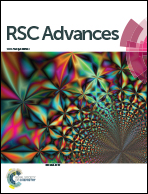Superhydrophilic and underwater superoleophobic mesh coating for efficient oil–water separation
Abstract
Metal meshes were conveniently coated with a nanoflake honeycomb network through NiOOH seeding and growth on a substrate during a chemical bath deposition process. The resultant meshes exhibited outstanding superhydrophilicity and underwater superoleophobicity, and supported high separation efficiency (>98%) and good reusability in oil–water separation.


 Please wait while we load your content...
Please wait while we load your content...